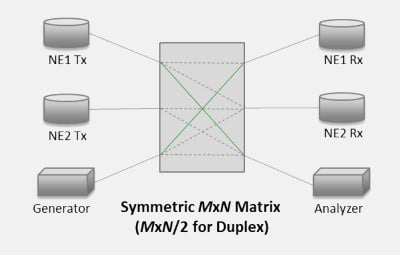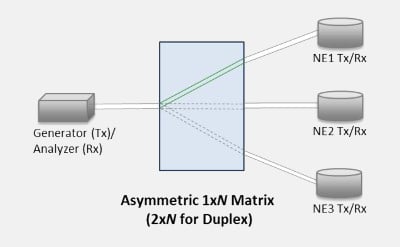While there are a number of aspects that can be discussed in regards to optical switching technology, the focus of this article is to provide information about two key categories of optical switches – symmetric and asymmetric. The concept is very straightforward, but still important to understand when determining which type of optical switch will be most suitable for a given application.
Symmetric Optical Switches
Symmetric optical switches are defined as having an equal number of input (M) and output (N) ports (MxN, where M=N) and can vary in size from a 2x2 to a 320x320 or larger. Symmetric switches are typically based on a non-blocking switch matrix providing a path from any input to any output, which permits any-to-any connectivity. While any-to-any connectivity enables all ports to be connected simultaneously, a single input can only connect to a single output. So, if all ports are simultaneously connected and a connection needs to be changed, another connection must be disconnected to accommodate this change.

In terms of applications, symmetric optical switches are useful and better suited for a dynamic topology, where frequent changes are required for connecting to/with all network devices. One of the most common applications is test environment automation, where the topology needs to change rapidly so that any port on a DUT can reach any test generator or analyzer.
Asymmetric Optical Switches
Just the opposite of a symmetric arrangement, asymmetric optical switches are defined as having an unequal number of input (M) and output (N) ports (MxN where M≠N). An optical switch of this type could be as simple as a 1xn (where N>1), or an MxN (where M<N). Common examples of these are 1x2 or 64x128. Similar to symmetric switches, asymmetric optical switches also use a non-blocking switch matrix; however, the number of simultaneous connections is equal to the number of input ports. For example, a 1xn can only have one connection active at a time; whereas, a 64xn can have 64 connections active at a time. Unlike a symmetric switch, many times a connection on an asymmetric switch can be changed without moving any other connections.

This “any-to-any” (or one-to-any, in the case of 1xN) type of optical switch is ideal for static topologies that require protection switching, which can be done with one or more 1x2s. It is also useful in product test environments that require the ability to transmit a signal from one device to one of many others, where a larger 1xN duplex switch is needed. One of the more common applications for asymmetric switches is network monitoring. Network monitoring applications typically require an asymmetric switch to share a test or analysis tool on-demand across multiple devices and paths in the network. In this scenario, the asymmetric switch generally accesses the network through taps to prevent the disruption of data between the source and destination.
Ultimately, when requiring an optical switch for any application, is it important to understand the types that are available to determine the most suitable solution. If you wish to learn more, or wish to discuss the right type of optical switch for an application, the M2 Optics team is always available to offer assistance and expertise at your convenience.
View the Most Flexible Optical Switching Platform






